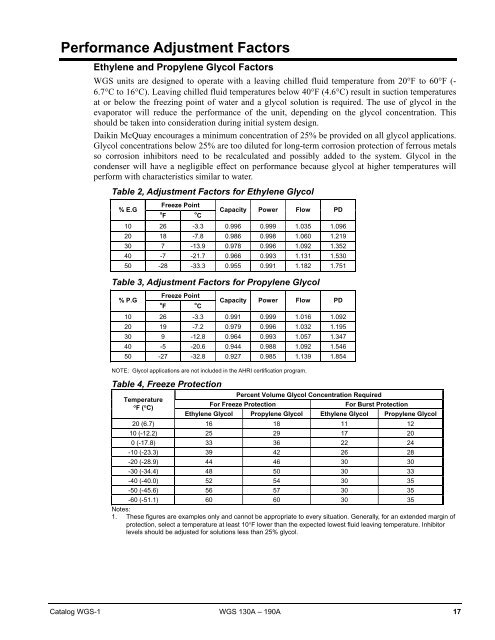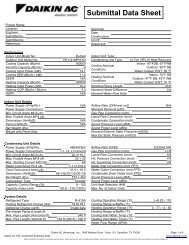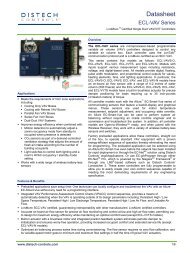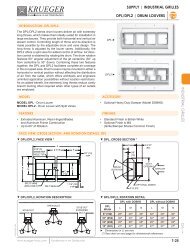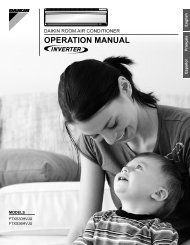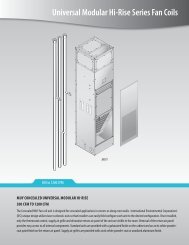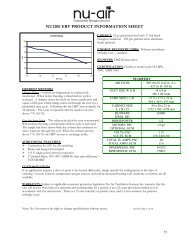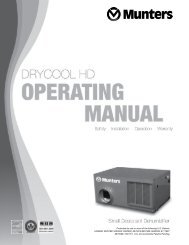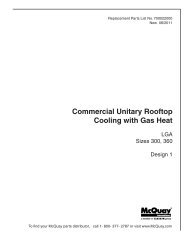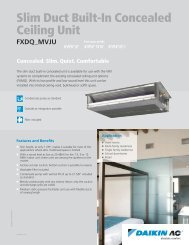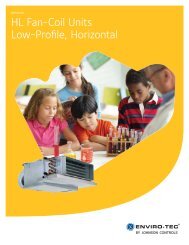Water-Cooled Condensers - HTS
Water-Cooled Condensers - HTS
Water-Cooled Condensers - HTS
Create successful ePaper yourself
Turn your PDF publications into a flip-book with our unique Google optimized e-Paper software.
Performance Adjustment FactorsEthylene and Propylene Glycol FactorsWGS units are designed to operate with a leaving chilled fluid temperature from 20F to 60F (-6.7C to 16C). Leaving chilled fluid temperatures below 40F (4.6C) result in suction temperaturesat or below the freezing point of water and a glycol solution is required. The use of glycol in theevaporator will reduce the performance of the unit, depending on the glycol concentration. Thisshould be taken into consideration during initial system design.Daikin McQuay encourages a minimum concentration of 25% be provided on all glycol applications.Glycol concentrations below 25% are too diluted for long-term corrosion protection of ferrous metalsso corrosion inhibitors need to be recalculated and possibly added to the system. Glycol in thecondenser will have a negligible effect on performance because glycol at higher temperatures willperform with characteristics similar to water.Table 2, Adjustment Factors for Ethylene Glycol% E.GFreeze PointFCCapacity Power Flow PD10 26 -3.3 0.996 0.999 1.035 1.09620 18 -7.8 0.986 0.998 1.060 1.21930 7 -13.9 0.978 0.996 1.092 1.35240 -7 -21.7 0.966 0.993 1.131 1.53050 -28 -33.3 0.955 0.991 1.182 1.751Table 3, Adjustment Factors for Propylene Glycol% P.GFreeze PointFCCapacity Power Flow PD10 26 -3.3 0.991 0.999 1.016 1.09220 19 -7.2 0.979 0.996 1.032 1.19530 9 -12.8 0.964 0.993 1.057 1.34740 -5 -20.6 0.944 0.988 1.092 1.54650 -27 -32.8 0.927 0.985 1.139 1.854NOTE: Glycol applications are not included in the AHRI certification program.Table 4, Freeze ProtectionPercent Volume Glycol Concentration RequiredTemperatureFor Freeze ProtectionFor Burst ProtectionF (C)Ethylene Glycol Propylene Glycol Ethylene Glycol Propylene Glycol20 (6.7) 16 18 11 1210 (-12.2) 25 29 17 200 (-17.8) 33 36 22 24-10 (-23.3) 39 42 26 28-20 (-28.9) 44 46 30 30-30 (-34.4) 48 50 30 33-40 (-40.0) 52 54 30 35-50 (-45.6) 56 57 30 35-60 (-51.1) 60 60 30 35Notes:1. These figures are examples only and cannot be appropriate to every situation. Generally, for an extended margin ofprotection, select a temperature at least 10F lower than the expected lowest fluid leaving temperature. Inhibitorlevels should be adjusted for solutions less than 25% glycol.Catalog WGS-1 WGS 130A – 190A 17


